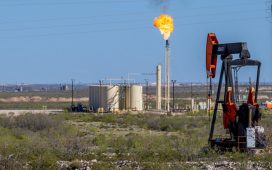
Fracking in Colorado.
Could a ban on fracking happen? Would it benefit the nation? Democratic presidential candidates and some incumbent officeholders have recently called for a ban on the hydraulic fracturing of oil and gas wells, which is used to boost recovery from shale formations.
In 2012, my colleagues and I visited the topic with “The Arithmetic of Shale Gas,” in which we found that U.S. consumers benefited by more than $100 billion per year in lower natural gas prices. We contrasted that consumer gain with the harm from fracking asserted by activists (but unsubstantiated by a major Obama administration study).
So what, if anything, has changed since then? For one thing, the annual financial benefits to consumers from fracking have almost doubled as natural gas prices dropped. And we have learned more about the environmental impacts, including how to manage them.
Today, annual domestic natural gas consumption is approximately 31 trillion cubic feet, compared to 23 trillion cubic feet in 2008. The Henry Hub benchmark average price of natural gas was approximately $2.56/thousand cubic feet, or mcf, in 2019, versus $8.86/mcf in 2008, suggesting an approximate gain to U.S. consumers in 2019 of $195 billion.
Therefore, over the past 10 years, consumers have saved more than one trillion dollars. That’s $1,000,000,000,000 — real money even to politicians. With that much, and more, at stake, any argument against fracking needs to be well-founded.
Impacts of fracking
Can we quantify negative impacts of fracking?
Many opponents continue to claim that fracking damages subterranean aquifers, but there is little evidence to support that claim. A study by Yale School of the Environment faculty, published in the Proceedings of the National Academy of Sciences, found no impact on groundwater contamination from drilling operations and hydraulic fracturing in the Marcellus shale. A recent paper published in the same journal by the Pennsylvania Department of Environmental Protection found no evidence of contamination in Pennsylvania streams traversing the Marcellus.
In those operations where groundwater contamination has been detected, the producers have either made reparations—internalizing the negative externality by paying for the water—or are subject to continued litigation and enforcement proceedings.
Opponents often cite the use of water supplies as a reason to abolish fracking. Water usage is necessary—hydraulic fracturing literally means using water—but oil and gas producers pay for the water they use. Producers buy the water from willing sellers and frequently recycle the water in their operations. The amount of water used is not large compared to other users. But the real measure of damage would be very high prices for water in the shale basins, and there is no evidence of that.
Earthquakes have been found to be closely associated with the practice of hydraulic fracturing and, in particular, with the disposal of wastewater into wells. Because water is a fluid with little ability to be compressed, few geologists dispute the impact of wastewater disposal wells. Litigation among landowners and producers continues. In Oklahoma, the regulatory body moved quickly to reduce the injection of wastewater into disposal wells and reduced the incidence of earthquakes.
The flaring and venting of natural gas in many of the nation’s shale basins is a problem. The Colorado Oil & Gas Conservation Commission has imposed stringent limitations on this wasting of a natural resource. In Texas’ Permian Basin, natural gas production is more often classified as “associated production,” where the gas is produced as a byproduct of primary oil production, and the flared quantities of natural gas exceed the amounts consumed by some states. Angry shareholders decry the waste while the Texas Railroad Commission considers various plans of attack. In the Permian, the price of natural gas has been negative in recent years as the supply overwhelms takeaway capacity—that is, producers have to pay consumers to take the natural gas away.
To date, there is no cost to producers for flaring gas beyond the lost revenues. Based on the highest estimate of flared gas in the Permian, 900 million cubic feet over a year, the lost annual revenue is $657 million at $2/mcf; at $3/mcf, it is $985.5 million. This cost can be applied against the benefits of fracking. (Worldwide flaring for 2018 is estimated at 5.1 billion cubic feet.)
The increased use of natural gas at the expense of coal has lowered the nation’s CO2 emissions absolutely and by a net 150 million metric tons in 2019, according to a Rhodium Group study and projections by the Energy Information Agency. If we value the CO2 at $30 per metric ton, that is a $4.5 billion benefit. More progress could be made if we built new natural gas pipelines to New England but entrenched commercial and political interests continue to support the use of dirty heating oil in the region despite the fact that it is 300% more costly per Btu than natural gas and emits 30% more CO2 than natural gas. At present, there is no financial cost associated with CO2 production from flaring or other oil and gas operations. A future carbon tax at the wellhead would impose a cost based on all produced natural gas whether it is flared, used for electricity production or as a feedstock for industrial products.
Venting of natural gas is unequivocally bad because methane is 84 times more potent a greenhouse gas than CO2 over the first 20 years after release. Producers lose money and consumers lose supply. While the EPA reports that since 1990 the U.S. has continued a trend of reducing methane emissions, more can be done. However it does not follow that a U.S. ban on fracking that turns the U.S. into a net importer of natural gas would result in a net reduction of global methane emissions.
Gains
The contributions to GDP from the lower price of natural gas on both revenues and employment have been somewhat offset by lost revenues and unemployment in the coal industry and lost gas producer profits. Positive net exports of natural gas via pipelines and LNG have begun to contribute incrementally to GDP. New downstream production of plastics, glass, fertilizers and other products produced from natural gas have added to GDP from renascent manufacturing in states such as Pennsylvania, Texas and Louisiana.
U.S. domestic oil production reached 12.5 million barrels per day for 2019; that includes more than 8 million barrels per day produced from shale formations. Pundits and politicians push the myth of U.S. energy independence from the global oil market, a canard that is obviously incorrect because the U.S. still must import between 5 million and 7 million barrels per day of heavy oil to be used in our refineries, which are designed to run on heavy oil, not the light oil produced from shale formations. However, the 8 million barrels per day produced from shale boosts annual GDP by almost $169 billion at the 2019 average benchmark price of $58/bbl and maintained 7.5 million jobs, assuming five jobs for every $1 million of GDP, or about double the popular vote margin in the 2016 presidential election.
Costs and Benefits
The annual gains to consumers and the nation from increased GDP would appear to outweigh the costs associated with fracking by a vast margin. Eliminating fracking would reduce production of both natural gas and oil over time, as a recent study by Michael Lynch of the Energy Policy Research Foundation Inc. details. Consumers (voters) would inevitably suffer from higher natural gas prices and higher electricity prices. GDP would suffer directly with increased unemployment as the U.S. once again becomes a net importer of natural gas. Lower oil production would also bring unemployment, lower tax revenues and lower GDP. Higher oil prices would not be out of the question.
There is no evidence that a frack ban would reduce U.S. emissions. The development of natural gas fueled vehicles to reduce emissions from gasoline or diesel powered vehicles would stall. Backsliding to coal as a fuel for power could easily reverse net gains that have been realized in reduced emissions. To the extent the U.S. would rely upon more imported natural gas and oil, our net global emissions will not be reduced by our suppliers in OPEC or Russia. As a global citizen, our new leadership would be ridiculed for sanctimoniously exporting our emissions and negative environmental impact to countries less able or less willing to cope.
Banning fracking will likely lead to unemployment and higher prices for heating, electricity and gasoline, and even more emissions—bad outcomes for politicians running for office.








